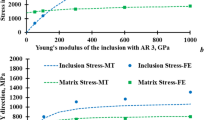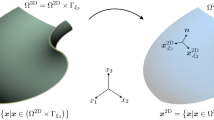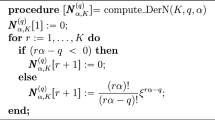Abstract
In this paper, a strong form meshfree collocation method is developed for two-dimensional single-body frictional contact problems. In this approach, a point-wise Taylor series approximation and generalized moving least squares approach is used to construct numerical differential operators at discrete points within the domain. The differential operators are then used to spatially discretize and solve the governing partial differential equations. Contact constraint conditions are formulated with the penalty approach. To demonstrate the efficiency of the method, benchmark problems in frictionless and frictional contact relevant to a rigid pile and an elastic foundation contact are provided. The numerical results are also compared with the finite element solutions to verify robustness and accuracy of the method.






















Similar content being viewed by others
References
Hallquist J, Goudreau G, Benson D (1985) Sliding interfaces with contact-impact in large-scale Lagrangian computations. Comput Methods Appl Mech Eng 51(1–3):107–137
Simo JC, Wriggers P, Taylor RL (1985) A perturbed Lagrangian formulation for the finite element solution of contact problems. Comput Methods Appl Mech Eng 50(2):163–180
Benson DJ, Hallquist JO (1990) A single surface contact algorithm for the post-buckling analysis of shell structures. Comput Methods Appl Mech Eng 78(2):141–163
Papadopoulos P, Taylor RL (1992) A mixed formulation for the finite element solution of contact problems. Comput Methods Appl Mech Eng 94(3):373–389
Wriggers P, Schröder J, Schwarz A (2013) A finite element method for contact using a third medium. Comput Mech 52(4):837–847
Wohlmuth BI (2001) Iterative solvers based on domain decomposition. In: Discretization methods and iterative solvers based on domain decomposition. Lecture Notes in Computational Science and Engineering, vol. 17. Springer, Berlin, Heidelberg. https://doi.org/10.1007/978-3-642-56767-4_2
Belgacem FB, Maday Y (1994) A spectral element methodology tuned to parallel implementations. Comput Methods Appl Mech Eng 116(1–4):59–67
Belhachmi Z, Bernardi C (1994) Resolution of fourth-order problems by the mortar element method. Comput Methods Appl Mech Eng 116(1–4):53–58
Maday Y, Mavriplis C, Patera A (1988) Nonconforming mortar element methods: application to spectral discretizations (No. NASA-CR-181729).
Bernardi C, Maday Y, Patera AT (1993) Domain Decomposition by the Mortar Element Method. In: Kaper, H.G., Garbey, M.,Pieper, G.W. (eds) Asymptotic and Numerical Methods for Partial Differential Equations with Critical Parameters. NATO ASI Series, vol 384. Springer, Dordrecht. https://doi.org/10.1007/978-94-011-1810-1_17
Belgacem FB, Hild P, Laborde P (1997) Approximation of the unilateral contact problem by the mortar finite element method. Comptes Rendus de l’Academie des Sciences Series I Mathematics 324(1):123–127
Belgacem FB, Hild P, Laborde P (1998) The mortar finite element method for contact problems. Math Comput Model 28(4–8):263–271
McDevitt T, Laursen T (2000) A mortar-finite element formulation for frictional contact problems. Int J Numer Methods Eng 48(10):1525–1547
Puso MA, Laursen TA (2004) A mortar segment-to-segment contact method for large deformation solid mechanics. Comput Methods Appl Mech Eng 193(6–8):601–629
Yang B, Laursen TA, Meng X (2005) Two dimensional mortar contact methods for large deformation frictional sliding. Int J Numer Methods Eng 62(9):1183–1225
Kim TY, Dolbow J, Laursen T (2007) A mortared finite element method for frictional contact on arbitrary interfaces. Comput Mech 39(3):223–235
Yoon Y-C, Song J-H (2014) Extended particle difference method for weak and strong discontinuity problems: part i. Derivation of the extended particle derivative approximation for the representation of weak and strong discontinuities. Comput Mech 53(6):1087–1103
Yoon Y-C, Song J-H (2014) Extended particle difference method for weak and strong discontinuity problems: part ii. formulations and applications for various interfacial singularity problems. Comput Mech 53(6):1105–1128
Yoon Y-C, Song J-H (2014) Extended particle difference method for moving boundary problems. Comput Mech 54(3):723–743
Lancaster P, Salkauskas K (1981) Surfaces generated by moving least squares methods. Math Comput 37(155):141–158
Belytschko T, Lu YY, Gu L (1994) Element-free Galerkin methods. Int J Numer Methods Eng 37(2):229–256
Lu Y, Belytschko T, Gu L (1994) A new implementation of the element free Galerkin method. Comput Methods Appl Mech Eng 113(3–4):397–414
Liu WK, Jun S, Zhang YF (1995) Reproducing kernel particle methods. Int J Numer Methods Fluids 20(8–9):1081–1106
Liu WK, Jun S, Li S, Adee J, Belytschko T (1995) Reproducing kernel particle methods for structural dynamics. Int J Numer Methods Eng 38(10):1655–1679
Liu W, Li S, Belytschko T (1997) Moving least square kernel Galerkin method\(\pm\)part i: methodology and convergence. Comput Methods Appl Mech Eng 143:422–433
Li S, Liu WK (1999) Reproducing kernel hierarchical partition of unity, part i-formulation and theory. Int J Numer Methods Eng 45(3):251–288
Li S, Liu WK (1999) Reproducing kernel hierarchical partition of unity, part ii-applications. Int J Numer Methods Eng 45(3):289–317
Kim DW, Kim Y (2003) Point collocation methods using the fast moving least-square reproducing kernel approximation. Int J Numer Methods Eng 56(10):1445–1464
Lee S-H, Kim K-H, Yoon Y-C (2016) Particle difference method for dynamic crack propagation. Int J Impact Eng 87:132–145
Fu Y, Michopoulos JG, Song J-H (2017) Bridging the multi phase-field and molecular dynamics models for the solidification of nano-crystals. J Comput Sci 20:187–197
Song J-H, Fu Y, Kim T-Y, Yoon Y-C, Michopoulos JG, Rabczuk T (2018) Phase field simulations of coupled microstructure solidification problems via the strong form particle difference method. Int J Mech Mater Des 14, 491–509. https://doi.org/10.1007/s10999-017-9386-1
Almasi A, Beel A, Kim T-Y, Michopoulos JG, Song J-H (2019) Strong-form collocation method for solidification and mechanical analysis of polycrystalline materials. J Eng Mech 145(10):04019082
Yoon Y-C, Schaefferkoetter P, Rabczuk T, Song J-H (2019) New strong formulation for material nonlinear problems based on the particle difference method. Eng Anal Bound Elem 98:310–327
Beel A, Kim T-Y, Jiang W, Song J-H (2019) Strong form-based meshfree collocation method for wind-driven ocean circulation. Comput Methods Appl Mech Eng 351:404–421
Chen J-S, Wang H-P (2000) New boundary condition treatments in meshfree computation of contact problems. Comput Methods Appl Mech Eng 187(3–4):441–468
Li G, Belytschko T (2001) Element-free Galerkin method for contact problems in metal forming analysis. Eng Comput 18(1/2):62–78
Xiao J, Gama B, Gillespie J Jr, Kansa E (2005) Meshless solutions of 2d contact problems by subdomain variational inequality and mlpg method with radial basis functions. Eng Anal Bound Elem 29(2):95–106
De Lorenzis L, Evans J, Hughes TJ, Reali A (2015) Isogeometric collocation: Neumann boundary conditions and contact. Comput Methods Appl Mech Eng 284:21–54
Kruse R, Nguyen-Thanh N, De Lorenzis L, Hughes TJ (2015) Isogeometric collocation for large deformation elasticity and frictional contact problems. Comput Methods Appl Mech Eng 296:73–112
Weeger O, Yeung S-K, Dunn ML (2017) Isogeometric collocation methods for Cosserat rods and rod structures. Comput Methods Appl Mech Eng 316:100–122
Temizer I, Wriggers P, Hughes TJR (2011) Contact treatment in isogeometric analysis with NURBS. Comput Methods Appl Mech Eng 200(9–12):1100–1112
Temizer I, Wriggers P, Hughes TJR (2012) Three-dimensional mortar-based frictional contact treatment in isogeometric analysis with NURBS. Comput Methods Appl Mech Eng 209:115–128
Hibbitt H, Karlsson B, Sorensen P (2012) Abaqus theory manual, version 6.12. Pawtucket, Rhode Island
Renaud C, Feng Z-Q (2003) Bem and fem analysis of Signorini contact problems with friction. Comput Mech 31(5):390–399
Kikuchi N, Oden JT (1988) Contact problems in elasticity: a study of variational inequalities and finite element methods, vol 8. SIAM, Philadelphia
Almasi A, Kim T-Y, Laursen TA, Song J-H (2019) A strong form meshfree collocation method for frictional contact on a rigid obstacle. Comput Methods Appl Mech Eng 357:112597
Christensen P, Klarbring A, Pang J-S, Strömberg N (1998) Formulation and comparison of algorithms for frictional contact problems. Int J Numer Methods Eng 42(1):145–173
Author information
Authors and Affiliations
Corresponding author
Additional information
Publisher's Note
Springer Nature remains neutral with regard to jurisdictional claims in published maps and institutional affiliations.
Appendices
Appendices
Appendix
The global system of equation can be written
The components of \(K^{int}\) matrix are
The components of \(K^{D}\) matrix are
The components of \(K^{N}\) matrix are
The components of \(K^{c}\) matrix for stick case are
where \(K_{I1J1}^{N}\), \(K_{I2J1}^{N}\), \(K_{I1J2}^{N}\), and \(K_{I2J2}^{N}\) can be obtained from Eq. (56). The component of stiffness matrix \(K^{stick}\) in Eq. (57) defined as
The components of \(\mathbf{f}^c _{stick}\) vector are
The components of \(K^{c}\) matrix for stick case are
The component of stiffness matrix \(K^\mathrm{slip}\) in Eq. (59) defined as
The components of \(\mathbf{f}^c _\mathrm{slip}\) vector are
Rights and permissions
About this article
Cite this article
Almasi, A., Kim, TY. & Song, JH. Strong form meshfree collocation method for frictional contact between a rigid pile and an elastic foundation. Engineering with Computers 39, 791–807 (2023). https://doi.org/10.1007/s00366-022-01673-y
Received:
Accepted:
Published:
Issue Date:
DOI: https://doi.org/10.1007/s00366-022-01673-y




